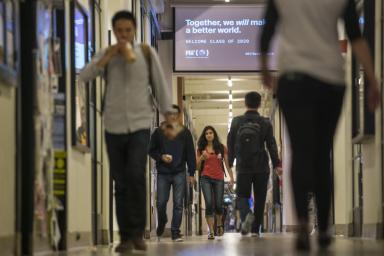Defining Living Labs
< Go back to main Living Lab page
< Go back to main Living Lab page

Living labs that advance sustainability is a place-based research platform that leverages the college campus as a test-bed for innovation and the co-production of sustainability knowledge. Below we have outlines our work in progress to reflect how we are defining and utilizing the campus as a test bed at MIT.
Living labs:
Rigorous campus-based research with operational, academic partners, sustainable data collection/analysis, formal and informal learning activities and measurable outcomes.
Big Ideas
Ideas for solutions come from anywhere, such as students seeking solutions, staff making observations from their everyday environments, or faculty or researchers who are experts at a given topic. Living labs are seeking a solution to a specific problem, and enable understanding, and innovation.
Place
The place attribute is different from one research project to the next, even though all work may technically take place somewhere within the campus boundaries. Living labs comprise spaces that are owned and managed by key stakeholders. Facilitating access and control required for extended experimentation would not otherwise be possible, without the institutional ownership of the buildings and land.
Diverse Partnerships
Living Labs have the potential to help reconcile tensions between addressing applied sustainability challenges and the more traditional chard of universities involved with academic research by integrating research, curricula, pedagogical method and community engagement, offering new spaces for experiential learning in diverse communities
Sustained Data Collection
Data collection can drive interdisciplinary collaboration. It is interesting to note that in living labs, data may be collected on every aspect of an experiment to identify patterns and to make robust casual inferences.
Formal and Informal Learning Opportunities
Learning unfolds through a wider community of stakeholders (in comparison to individual discoveries). Learning is a social process for issue formation, monitoring assessment, evaluation, negotiation and conflict resolution. Learning opportunities may include credit or non-credit courses, learning by doing activities such as field study programs, or learning between operational staff and researchers occurring in real world context.
Outcomes
Outcomes may take many forms such as journal articles, public presentations, software, policies, new products or services, awards, behavior changes, etc. journal articles, awards, new technologies, data for decisions, software, pilot programs, books, community resources, new funding, feasibility studies, and the creation of new companies. It is important to measure the outcomes, and to keep track of them over time and as an administrator to understand
Feedback Loops
Feedback loops maybe observed at many points in the living lab research process. For instance, while determining research questions, scientists may obtain feedback from experts familiar with operational aspects of the campus. In a similar way, an awareness event featuring campus-based research may expose others to work previously unknown and provide new feedback to current work.
It has been observed that there are also numerous processes happening simultaneously in any given living lab:
Research Process
This includes linear or non-linear sequencing of research questions, literature review, design methodology, data collection/analysis
Ideation Process
This includes non-linear sequences such as intake/define, collaborate, digest, prototype, connect/reconnect, test/outcomes
Filter Process
This includes a non-linear process by which strategic decisions about the prioritization of new work, or about the next steps of existing work
Teaming Process
This includes aspects of the team launch, team build, team re-launch
Campus to Campus
This type represents research originated on the MIT Campus, that is then applied to the MIT Campus.
Campus to Market
This type of living lab represents research that is tested and refined by utilizing the MIT campus, and then applied directly to the market.
Market to Campus
This type of living lab originates from an external entity, and then it is tested on the MIT Campus, and then applied to the MIT Campus.